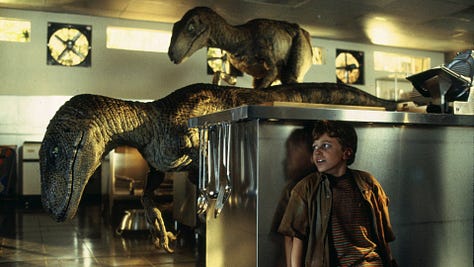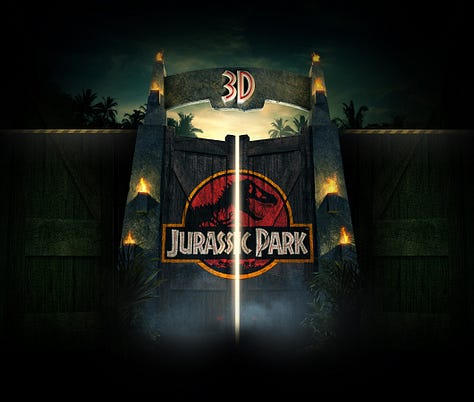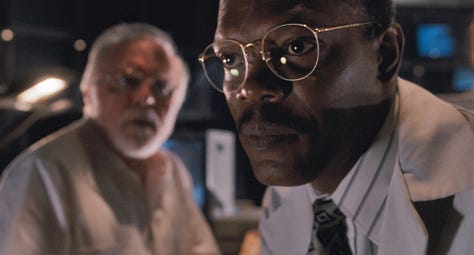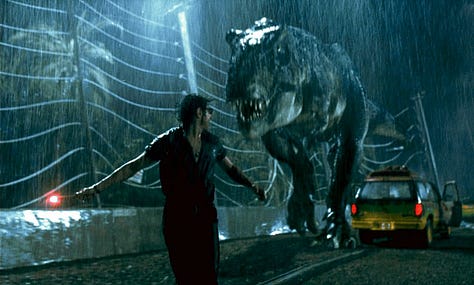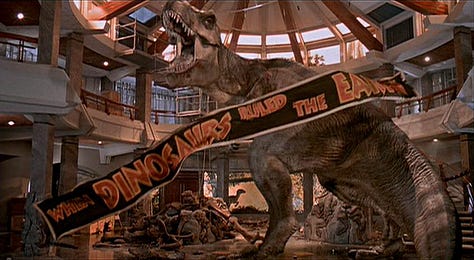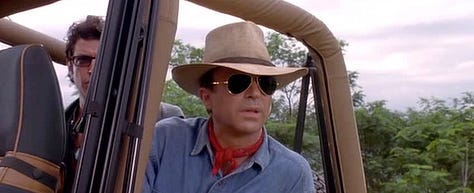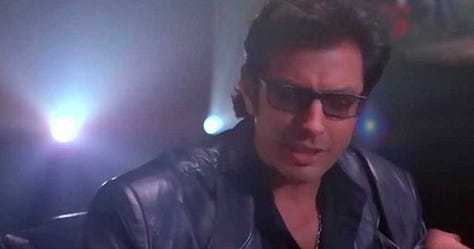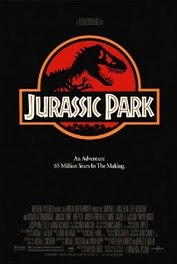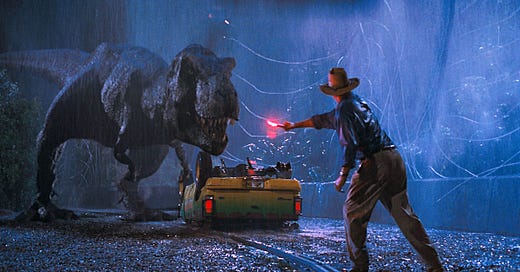JURASSIC PARK
1993 • Steven SpielbergCast: Sam Neill, Laura Dern, Jeff Goldblum, Richard Attenborough, Bob Peck, Martin Ferrero, BD Wong, Samuel L. Jackson, Wayne Knight, Joseph Mazzello, Ariana Richards
Screenplay: Michael Crichton, David Koepp; Based on Jurassic Park by Michael Crichton
Cinematography: Dean Cundey
Music: John Williams
Producer: Kathleen Kennedy, Gerald R. Molen
Universal Pictures
- All major theme parks have delays. When they opened Disneyland in 1956, nothing worked!
- Yeah, but, John, if The Pirates of the Caribbean breaks down, the pirates don't eat the tourists.
One of the biggest blockbusters of all time, Jurassic Park broke new ground in spectacular visual effects that still hold up today. Based on the best-selling book by Michael Crichton, it's almost impossible to find someone who has not seen this record-breaking blockbuster film. Billionaire industrialist John Hammond creates a groundbreaking theme park populated with genetically engineered dinosaurs. To ensure its safety, Hammond invites a group of experts, including paleontologists Dr. Alan Grant and Dr. Ellie Sattler, mathematician Dr. Ian Malcolm, as well as Hammond's own grandchildren. However, when a power failure occurs, the dinosaurs run rampant, putting everyone's lives at risk. The group must navigate the treacherous island, facing deadly encounters with the prehistoric creatures. As chaos ensues, they struggle to survive and escape the island in what is, in my opinion, the most perfect blockbuster film of all time.
Jurrasic Park was filmed and released during a pivotal period in special effects history: transitioning from primarily practical effects to incorporating more sophisticated computer-generated imagery (CGI). It seamlessly blended the two methods, bringing the giant lizards to life on the big screen in a way that had never been seen before. The best example of this synthesis is the iconic T-Rex attack scene. The filmmakers employed a life-sized animatronic T-Rex for many shots, allowing for tangible interactions between the actors and the creature. However, the true marvel was the use of CGI for dynamic and complex movements, such as the T-Rex chasing the characters in the Jeep. Another striking example of the synergy between practical and computer-generated effects in is the Velociraptor kitchen scene. As the two children, Tim and Lex, attempt to evade the relentless pursuit of the Velociraptors. For the close-quarter encounters, practical effects were utilized with the creation of life-sized Velociraptor props, allowing for physical interactions with the actors and the environment. However, as the Velociraptors moved with incredible agility and speed, especially when leaping onto countertops and stalking the children, CGI was integrated to enhance the fluidity and realism of their movements. This elevated the suspense and fear resulting in a sequence that remains etched in the minds of 90s kids everywhere.
The authenticity of the characters' reactions serves as a cornerstone in the success of the film, forging a crucial connection between the audience and the fantastical world of dinosaurs. Despite some criticism directed at child actors Joseph Mazzello and Ariana Richards in less action-packed moments, they undeniably shine in scenes of peril, specifically during the dinosaur attacks. In moments of imminent danger, Mazzello and Richards channel genuine fear and panic with convincing intensity. The emotions they convey create a connection with the audience to share in the their terror and vulnerability. These performances add an indispensable layer of authenticity, making the danger all the more convincing. Whether escaping from a velociraptor in the kitchen or cowering from the towering T-Rex in a parked jeep, Mazzello and Richards excel at portraying raw, unfiltered panic. (And honestly the criticisms of their acting are overblown anyway. They’re fine.)
Sam Neill's Dr. Alan Grant not only serves as the anchor for the film but also encapsulates the biggest character arc. At the outset, Dr. Grant is established as a no-nonsense paleontologist with an aversion to children, an aspect that becomes a recurring theme throughout the film. Grant is skeptical and uncomfortable around children, but as the story unfolds on Isla Nublar, he is forced to become a father figure to Lex and Tim, John Hammond’s grandchildren, in the most extreme situation possible. The initial reluctance to engage with the kids, gradually evolves into a genuine and protective connection. Neill skillfully portrays Grant's growing realization that, in the face of the dinosaur-induced chaos, he must become a the children’s surrogate guardian. The arc of Grant transforming from a man disinterested in family to a reluctant but ultimately caring father figure, showcases the versatility of Neill's talent. It’s no wonder that millennials that grew up with Jurassic Park have a deep fondness for Sam Neill/Alan Grant.
John Hammond serve as intriguing counterparts to Alan Grant. Richard Attenborough's portrayal of John Hammond is characterized by a mix of enthusiasm and naivety, casting him as the kindly grandfather figure with a vision for a groundbreaking theme park populated with genetically engineered dinosaurs. This stands in stark contrast to the gruff demeanor of Dr. Grant. Hammond's genuine excitement and paternal affection towards his grandchildren and (almost more so) the park's attractions create an initial impression of an eccentric but well-intentioned billionaire. However, when all Hell breaks loose, Attenborough captures the complexity of Hammond's character. The clash between his ambitious dreams and the uncontrollable forces unleashed by the dinosaurs reveals a deeper, more conflicted, and greedy side of the character. Hammond's naivety, and his stubbornness to make the park work, are juxtaposed against the harsh realities of nature, and the consequences of his unchecked ambition become evident. Interestingly, the contrast between Hammond and Grant becomes particularly poignant in the film's climax. Despite Hammond's grandfatherly demeanor, it is Dr. Grant whom the children seek comfort from after their harrowing adventure, not Hammond. This shift reflects the unintended consequences of Hammond's grand vision. Hammond’s hubris not only cost him his theme park, but potentially the love of his grandchildren.
Laura Dern, meanwhile, as Dr. Ellie Sattler transcends conventional gender roles, showcasing a character with depth, intelligence, and agency. While initially implied as having more parental instincts than her professional and romantic partner Dr. Grant, Dern's performance ensures that Sattler is not defined solely by traditional caregiving roles. Early on, before all hell breaks loose on the island, she is shown as capable and intelligent, her demonstrating her scientific knowledge as well as compassion when caring for the sick triceratops. Dern injects a bit of feminist wit and assertiveness into Dr. Sattler, particularly in her interactions with Jeff Goldblum's Ian Malcolm and Richard Attenborough’s John Hammond. Her "woman inherits the earth" retort to Malcolm demonstrates she’s unafraid to assert herself. She eloquently and exasperatedly lectures Hammond on his inherent sexism. Rather than fitting the damsel in distress trope, Sattler emerges as a heroine in her own right. When separated from Grant, she refuses to be a passive victim awaiting rescue. Dr. Sattler becomes a beacon of resilience and leadership. She takes active steps to ensure her and her group's survival, rebooting the power grids and exhibiting the courage to face peril head-on. By the conclusion of "Jurassic Park," Laura Dern's Ellie Sattler emerges as a fully realized action hero. Her strength, intelligence, and unwavering determination make her a standout character. Dern's performance not only defied stereotypes but also made many adolescent boys in 1993 fall in love with her.
Jeff Goldblum's portrayal of Dr. Ian Malcolm is his usual tour de force of charismatically quirky unpredictability, which is perfect since he plays a rock star mathematician and chaos theorist. He adds his uniquely distinct flavor to the film, which is always welcome. Goldblum's delivery of witty and insightful dialogue, coupled with his idiosyncratic mannerisms, transforms Malcolm into a character who defies the traditional scientist archetype. Goldblum’s eccentricity infuses Ian Malcolm’s charming arrogance making him a standout presence in the film. (That and the completely unnecessary shirtless hunky pose… you know the one.) In contrast to Dr. Sattler's active role in the face of danger, Malcolm's character undergoes an interesting twist. While he contributes valuable insights and performs a heroic feat by luring the T-Rex away from the kids, he finds himself sidelined for a significant portion of the movie after sustaining an injury. This flip of the traditional gender roles adds a layer of unpredictability to the film. Despite his initial bravado, Malcolm becomes, in essence, a damsel in distress himself. Goldblum's performance is a key element to this twist. He seamlessly transitions from the cocky mathematician to a vulnerable character in need of assistance. (“Must go faster.”) In most other films, Malcolm would be a more active hero. It’s fitting that his character becoming physically vulnerable for a good portion of the runtime is as unpredictable as the chaos theory Malcolm studies. Malcolm is a microcosm of the chaos that is the park itself. Because when prehistoric nature suddenly runs rampant on the island, predictability goes out the window.
The supporting cast, specifically Wayne Knight and Samuel L. Jackson, populate the film nicely. Knight portrays the deceitful and bumbling IT expert Dennis Nedry with a perfect blend of humor and menace. His character's pivotal role in the chaos that ensues showcases Knight's ability to balance comedic elements with the darker undertones of the plot. Fans of his character Newman from the “Seinfeld” sitcom, will delight in seeing his devilish face on-screen. Jackson, in the role of Ray Arnold, brings a no-nonsense attitude to the film as one of the computer engineers. His "Hold onto your butts" adds a touch of levity to the impending danger, and cements an iconic movie quote into the lexicon. Jackson had not quite hit his iconic status yet, but that was on the way as Pulp Fiction was just about a year away from blasting unapologetically into the zeitgeist.
Jurassic Park is one of the most beloved adventure popcorn movies of all time, and is perhaps the greatest blockbuster next to Spielberg’s other nature-gone-beserk classic, Jaws. Jurassic Park broke all the box office records. It spawned two sequels of diminishing quality with The Lost World in 1997 and Jurassic Park III in 2001. After over a decade laying dormant, the franchise had a soft reboot in 2015 with an equally financially successful Jurassic World, which launched a new trilogy of films that included Fallen Kingdom and Dominion. Despite the lower qualities of those films, the original 1993 film is still the king of the prehistoric world, roaring like a triumphant T-Rex.
Your scientists were so preoccupied with whether or not they could that they didn't stop to think if they should.
Notable Awards & Accomplishments
Original Theatrical Box Office: $914 Million
3 Academy Award Wins including Best Visual Effects
National Film Registry: Inducted in 2018
Streaming: Prime, TBS
Digital Rental/Purchase: Available at most major digital retailers
Physical Media: Available on 4K, Blu-Ray and DVD
